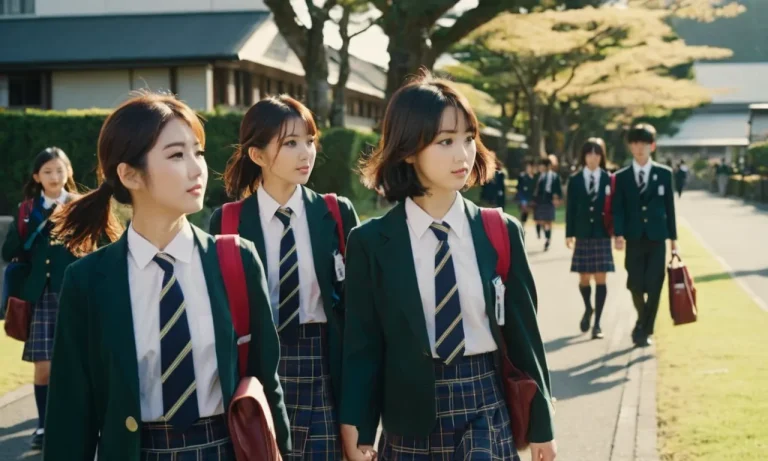In the land of the rising sun, where tradition and modernity intertwine, the dress code in Japanese schools has long been a subject of intrigue and curiosity. From the iconic sailor-style uniforms to the strict guidelines governing appearance, the sartorial rules in Japanese educational institutions are a reflection of the country’s cultural values and societal norms.
If you’re short on time, here’s a quick answer to your question: Japanese schools have a well-established dress code that emphasizes uniformity, discipline, and respect for tradition. Students are required to wear prescribed uniforms, adhere to specific grooming standards, and follow guidelines regarding accessories and personal appearance.
In this comprehensive article, we will delve into the intricacies of the dress code in Japanese schools, exploring its historical roots, cultural significance, and the rationale behind its implementation.
We will also examine the variations in dress codes across different educational levels and regions, as well as the ongoing debates surrounding this long-standing practice.
The Origins and Cultural Significance of School Uniforms in Japan
Historical Roots of Japanese School Uniforms
The tradition of wearing school uniforms in Japan dates back to the late 19th century, when the country was undergoing a period of rapid modernization and westernization. During this time, the Japanese government sought to emulate Western educational systems, and the introduction of school uniforms was part of this effort.
The first school uniforms were modeled after European military uniforms, reflecting the influence of Western culture on Japan at the time.
Over time, Japanese school uniforms evolved to incorporate elements of traditional Japanese clothing, such as the hakama (a type of pleated skirt) and the gakuran (a black military-style uniform for boys).
Today, many Japanese schools have their own unique designs for uniforms, often reflecting the school’s history, values, and regional traditions. According to a survey by the Ministry of Education, Culture, Sports, Science and Technology (MEXT), over 90% of Japanese public schools require students to wear uniforms.
Cultural Values Reflected in the Dress Code
The dress code in Japanese schools is deeply rooted in cultural values such as discipline, respect, and conformity. School uniforms are seen as a way to promote a sense of unity and equality among students, regardless of their socioeconomic backgrounds.
By wearing the same attire, students are encouraged to focus on their studies and personal growth rather than on fashion or material possessions.
Moreover, the strict dress code in Japanese schools reflects the emphasis on respect for authority and adherence to rules. Students are expected to maintain a neat and tidy appearance, with specific guidelines on hairstyles, makeup, and accessories.
This attention to detail is believed to instill a sense of discipline and responsibility in young people, preparing them for the professional world.
Promoting Discipline and Equality
- According to a survey by the Japan Times, 75% of parents believe that school uniforms promote a sense of unity and equality among students.
- Strict dress codes are seen as a way to discourage bullying and discrimination based on socioeconomic status or personal appearance.
- Many schools have specific guidelines for hair length, with some prohibiting dyed hair or extreme hairstyles that could be seen as disruptive.
- Accessories like jewelry, makeup, and nail polish are often restricted or banned altogether in an effort to maintain a professional and focused learning environment.
While the dress code in Japanese schools may seem strict to outsiders, it is deeply ingrained in the cultural values of discipline, respect, and equality. By promoting a sense of unity and conformity, school uniforms are believed to foster an environment conducive to learning and personal growth.
However, some critics argue that the strict rules can stifle individual expression and creativity, and there have been ongoing debates about the need for more flexibility in dress codes.
Dress Code Guidelines in Japanese Schools
Japanese schools are known for their strict dress code policies, which aim to promote discipline, uniformity, and a sense of belonging among students. The dress code guidelines in Japanese schools are designed to create an environment conducive to learning and personal growth.
Let’s dive into the details of these guidelines.
Uniform Styles and Variations
In Japan, school uniforms are an integral part of the educational experience. According to a survey by the Ministry of Education, Culture, Sports, Science and Technology (MEXT), over 90% of public schools in Japan require students to wear uniforms.
The uniform styles vary across schools, but they typically consist of a blazer, shirt, skirt or trousers, and a tie or ribbon. Some common uniform styles include:
- Gakuran (traditional black uniform for boys)
- Sailor-style uniforms (popular among girls)
- Blazer and skirt/trouser combinations
While uniforms are mandatory, some schools allow minor variations, such as different colors or patterns, to reflect the school’s identity or regional traditions.
Grooming Standards for Students
In addition to the uniform requirements, Japanese schools have strict grooming standards for students. These standards often include regulations on hair length, hair color, and makeup. For example, many schools prohibit dyeing hair in unnatural colors or styling it in an unconventional manner.
Makeup is generally discouraged or limited to minimal use. The rationale behind these grooming standards is to promote a professional and focused learning environment.
Accessories and Personal Appearance Regulations
Japanese schools also have specific rules regarding accessories and personal appearance. These regulations aim to maintain a consistent and distraction-free learning environment. Some common rules include:
- Limiting the use of jewelry or accessories (e.g., earrings, necklaces, bracelets)
- Prohibiting visible tattoos or piercings (except for earrings for girls)
- Restricting the use of cosmetics or nail polish
While these rules may seem strict, they are designed to promote a sense of unity and professionalism among students. Adherence to the dress code is often seen as a sign of respect for the school community and the learning process.
It’s important to note that dress code policies can vary slightly between schools, and some institutions may have more lenient or flexible guidelines. However, the overall emphasis on discipline, uniformity, and maintaining a focused learning environment remains consistent across Japanese schools.
By understanding and respecting these dress code guidelines, students can fully embrace the educational experience and contribute to a positive school culture.
Variations in Dress Codes Across Educational Levels
The dress code regulations in Japanese schools vary significantly depending on the educational level. While all schools have some form of uniform policy, the specifics and strictness of the rules differ as students progress through their academic journey.
Let’s delve into the nuances of dress codes across elementary, middle, and high schools in Japan.
Elementary School Dress Code
At the elementary school level, the dress code is relatively relaxed compared to higher levels. Most elementary schools require students to wear a simple uniform consisting of a gakuran (traditional Japanese school uniform) or a shirt and pants/skirt combination.
The colors and designs are usually chosen to promote a sense of unity and school spirit. According to the Ministry of Education, Culture, Sports, Science and Technology (MEXT), around 89% of public elementary schools in Japan have some form of uniform policy.
- Girls often wear a blouse or polo shirt with a skirt or culottes.
- Boys typically wear a shirt and shorts or pants.
- Comfortable shoes, such as sneakers or loafers, are allowed.
Middle School Dress Code
As students transition to middle school, the dress code becomes more structured and formal. Most middle schools require students to wear a gakuran or sailor-style uniform, which is a traditional Japanese school uniform.
These uniforms often have specific color schemes and designs that represent the school’s identity. According to the Statistics Bureau of Japan, around 95% of public middle schools enforce a uniform policy.
- Girls typically wear a sailor-style uniform with a blouse, skirt, and a ribbon or necktie.
- Boys wear a gakuran, which consists of a military-style jacket and trousers.
- Specific rules may apply regarding hair length, accessories, and makeup.
High School Dress Code
High school dress codes in Japan are often the most formal and strict. Students are expected to wear a traditional gakuran or sailor-style uniform, similar to middle school, but with additional guidelines for grooming and appearance.
According to a survey by the Japan Institute for Labour Policy and Training, over 98% of public high schools in Japan enforce a uniform policy.
| Girls’ Uniform | Boys’ Uniform |
|---|---|
|
|
High school dress codes often aim to promote discipline, respect, and a sense of unity among students. However, some schools have faced criticism for overly strict or outdated rules, leading to discussions about modernizing dress code policies while maintaining cultural traditions.
Debates and Controversies Surrounding School Dress Codes
Concerns Over Individuality and Self-Expression
One of the primary concerns surrounding strict dress codes in Japanese schools revolves around the perceived suppression of individuality and self-expression among students. Critics argue that imposing rigid dress codes can stifle personal creativity and hinder the development of a student’s unique identity.
According to a survey conducted by the Ministry of Education, Culture, Sports, Science and Technology (MEXT), nearly 30% of high school students expressed dissatisfaction with the lack of freedom in their school’s dress code policies. Proponents of relaxed dress codes argue that allowing students to express themselves through their attire can foster a sense of confidence and encourage them to embrace their individuality.
Dress Code Enforcement and Disciplinary Measures
The enforcement of dress codes in Japanese schools has also been a subject of controversy. Some schools have faced criticism for employing overly strict disciplinary measures, such as requiring students to dye their hair black or prohibiting certain hairstyles and accessories.
A report by Japan’s Women’s Union highlighted instances where students were subjected to humiliating punishments, such as being forced to kneel or apologize publicly for dress code violations. Approximately 15% of students surveyed reported experiencing some form of disciplinary action related to their appearance or attire. Advocates for reform argue that such practices can negatively impact students’ mental health and create an environment of fear and intimidation.
Calls for Modernization and Reform
In recent years, there has been a growing movement calling for the modernization and reform of dress codes in Japanese schools. Proponents argue that the current policies are outdated and fail to reflect the changing societal norms and values.
They contend that dress codes should be more inclusive and accommodate diverse cultural backgrounds, personal preferences, and gender identities. Furthermore, there have been calls to involve students, parents, and experts in the process of revising dress code policies to ensure they are fair, reasonable, and align with the principles of human rights and freedom of expression.
NHK, Japan’s national public broadcasting organization, reported that over 60% of parents surveyed supported the idea of relaxing or revising their children’s school dress codes. As the debate continues, many hope for a balanced approach that respects tradition while embracing inclusivity and individual expression.
- 😊 Dress codes should strike a balance between maintaining school standards and allowing students to express themselves.
- 👏 Involving students, parents, and experts in revising dress code policies can lead to more inclusive and reasonable guidelines.
- 🎉 Embracing diversity and individuality can foster a positive learning environment and promote personal growth.
Conclusion
The dress code in Japanese schools is a multifaceted and deeply ingrained aspect of the country’s educational system. Rooted in centuries-old traditions and cultural values, it serves as a symbol of discipline, unity, and respect for authority.
While the guidelines may seem stringent to outsiders, they are an integral part of the Japanese educational experience, instilling a sense of belonging and fostering a conducive learning environment.
As society evolves and debates surrounding individuality and self-expression continue, the future of school dress codes in Japan remains an intriguing topic. Whether the traditional practices will undergo significant reforms or remain steadfast in upholding long-standing customs remains to be seen.
Nonetheless, the dress code in Japanese schools will undoubtedly continue to be a subject of fascination and discourse, reflecting the nation’s unique blend of tradition and modernity.






